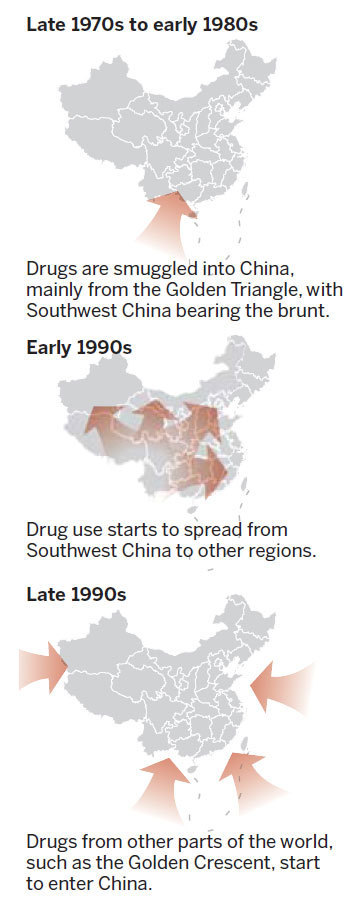Bumper harvest in Myanmar and rise in Afghan trafficking to blame

The fight against narcotics faces increasing challenges amid a bumper poppy harvest in Myanmar and a rise in Afghan drug trafficking, a police official said.
The poppy growing area in northern Myanmar has increased to 44,867 hectares this year, up 41 percent year-on-year, according to figures from the Ministry of Public Security.
Apart from producing traditional drugs, such as opium and heroin, northern Myanmar has also become the main source of the synthetic drug crystal methamphetamine, commonly referred to as ice, coming into China, Liu Yuejin, director of the ministry's narcotics control bureau, told China Daily.
Tuesday marks International Day Against Drug Abuse and Illicit Trafficking.
China seized 7.9 metric tons of ice coming from northern Myanmar last year, up 62 percent on the previous year. It accounted for 55 percent of all ice seized across the country, ministry figures show.
A major reason for the increase in poppy planting in Myanmar is due to political uncertainty, said Li Wenjun, a professor specializing in drug control with the Chinese People's Public Security University.
Meanwhile, the poppy planting area in Afghanistan reached 131,000 hectares in 2011, a year-on-year increase of 7 percent. Consequently, there has been a rise in drugs smuggled from that area, Liu said.
Drug control departments in the Xinjiang Uygur autonomous region last year cracked 10 major smuggling cases involving drugs from Afghanistan. The amount of heroin from Afghanistan seized was about 20 times more than what was seized in 2010, according to the ministry.
"Despite consistent efforts, China still faces a grim drug-control situation," Liu said.
Smuggled drugs mainly come from the Golden Triangle area, the world's major drug producing region that overlaps the mountains of Myanmar, Laos and Thailand, as well as the Golden Crescent region, which encompasses the mountain valleys of Iran, Afghanistan and Pakistan.
Chinese regions adjacent to these two areas - Southwest China's Yunnan province and Guangxi Zhuang autonomous region, as well as Xinjiang in Northwest China - have been worst hit, Liu said.
In addition, cocaine from South America is increasing, he added.
Domestic drug production is also expanding, Liu said.
Police uncovered 529 cases nationally involving drug manufacturing last year, an increase of 20 percent over 2010, according to figures from the ministry.
Liu said the popularity of the Internet makes it easier for criminals to contact each other.
"Production methods are evolving all the time, which makes crackdowns more difficult," he said.
Liu said more international cooperation in drug control is necessary, and more campaigns against drug production in China will be launched.
"China will strengthen international cooperation in terms of intelligence exchanges, pursuit of drug traffickers, repatriation and alternative crop development," Liu said.
In November, China, Laos, Myanmar and Thailand agreed to boost law enforcement and jointly conduct security operations along the Mekong River to combat drug and human trafficking.
Meanwhile, China has established a case-by-case cooperation mechanism with its three neighbors. Four police liaison offices have also been set up in border areas to facilitate investigations.
Under the agreement between China and Myanmar, police in both countries have arrested and repatriated about 60 fugitives since 2009, including drug lords, according to figures by the ministry.
However, experts warned that fighting drugs will be a long-term task.
"It's impractical to control the poppy cultivation in northern Myanmar and Afghanistan in the short term," Li said.
Liu Ce and Cao Yin contributed to this story.
zhangyan1@chinadaily.com.cn
